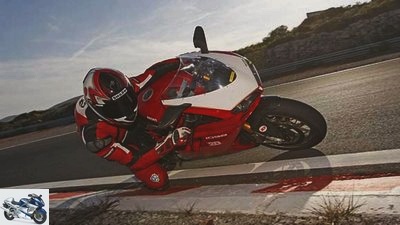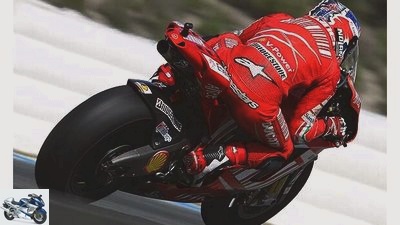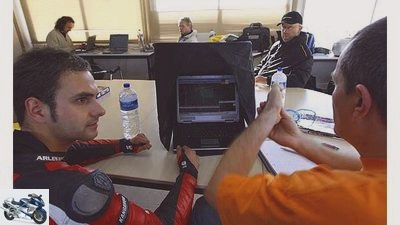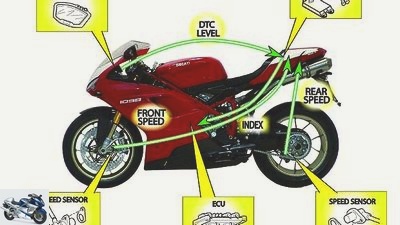Table of contents
- Technology report Traction control
- Traction control
- Curve dance
- Matrixed
- From level to level
- No more highsiders?
- Why not ABS in MotoGP?
- Interview Dirk “Mr. Knowledge” Debus

2snap
counselor
technology & future
Technology report
Technology report
Traction control
Content of
Traction control ?? Everyday in the car, hardly practicable in the motorcycle? Ducati brings the first series system in the 1098R? the highsider will die out like the dinosaurs once did thanks to diverse networked electronics?
Jorg Schuller
06/20/2008
Traction control
There is an expression for it in English: “the hungry cat”; Loosely translated: the greedy predator, ready to jump, aggressive, with sharp claws and teeth. If it bites, there is difficulty, there is danger, blood could flow – well, better take a few steps back. “The hungry cat” describes when the engine acts too nastily, sprints from a tame twist on the throttle grip like a prick, like an angry creature tears at the rear wheel – and sometimes causes undesirable slip there. Even with series bikes around 100 HP, difficult to control, fatal if a lot of horses break out. That of a MotoGP bike, for example, that of a current 1000 or that of the new one Ducati 1098R: With racing bags, the Duc lets a massive 183 horses off the crankshaft and kneads with over 100 Newton meters of torque from 3500 rpm.
Even gifted pilots are repeatedly torn by such monsters – what the 1098R with DTC, “Ducati Traction Control”, wants to prevent. Does technology herald the withdrawal of the highsider from the sport bike world, as has been happening in racing for some time? Experience acceleration, a pleasure without regrets? Even with the Duc, the right hand actually chooses the pull on the rear wheel: accelerate, get power. But is it really that simple? Not quite, because between command on the throttle and obedience on the rear wheel, ignition and injection times, combustion processes and gas exchange determine how many horsepower and in what form. Everything’s great, as long as cockiness and power don’t overwhelm the grip: traction, traction, traction, wheelspin, oooooh, slap. And preferably by highsider – the bruises keep you going for a long time.
Curve dance

K
Casey Stoner uses electronic controls like a TC like a world champion.
But wait: why not watch what the driver is up to and help in the right direction if there is too much euphoria? Where to start In principle, it is true to use dynamic wheel load distribution to set the largest possible contact area and thus fat grip on the tires. After the usual static friction when rolling, the effective world of gentle, controlled slip at the limit begins there – more or less wide, depending on the rubber quality and the potential of the driver, chassis and sub-structure of the tire. If this range is exceeded, the pilot and engine pull too hard, then it goes like this: Static friction becomes final sliding friction, the tire offers too little resistance to the lateral acceleration, the performance animals pull it off the track, ouch!
For safety or fast laps, it would be ideal to drive as close as possible to, but never over the border to the ouch – usually a question of feeling and driving talent. But since the spray supply and ignition timing are regulated by engine management, you can influence it: Welcome traction control, in short: TC. Electronics have long been celebrating considerable advances, brought us a gearshift and ABS, mastered the exhaust gas problem, with ignition / injection systems gradually displacing almost all carburettors. And slip regulations? First in Formula 1, then ESP for the production car. Only with the single-track motorcycle and its lean angle problem has it not really been possible to prevent uncontrolled spinning of the drive wheel.
BMW has been helping since 2007 with ASC, a reliable slip reducer, even if the Bavarians do not see the advantages of their system when accelerating from an incline. Ducati, on the other hand, is now openly propagating real traction control with DTC, a speed maker. Carefree throttle opening from a full incline – is that possible? Not everyone will try this, because DTC is currently only available in the exclusive 1098R for a brutal 35,000 euros. PS gets the 1098R on loan – albeit unfortunately only for a few days of testing. Test driver Arne Tode moved to Mireval to try out the eight levels of the DTC. Before that, PS wired the Queen of the Ducs with a brand new GPS kit system from 2D data recording. Recorded ignition signals, front and rear wheel speed, engine speed and throttle position as well as the longitudinal and lateral accelerations driven. And as an interesting waste product, the inclined position achieved.
Matrixed

K
The interaction of recordings and driver comments allows a reliable analysis of the measurement data.
It is remarkable that apart from the GPS no sensors were needed: The electrical matrix of the 1098R diligently collects its own data. A Hall sensor each determines the front and rear wheel speed, which the DTC then compares. Integrated in the DTC box, a gyro measures the inclination in three dimensions (via the change in angular velocity). Speed, throttle position and the gear engaged – already used by the engine management – do the rest. And it is precisely on the engine management system that DTC attacks: Calculates the driving status from the sensor signals – and causes ignitions to fail.
Whereby a fundamental problem arises: DTC only works together with open racing bags without a catalytic converter. In the standard trim, unburned fuel would get into the exhaust through the controlled misfires. The injection system stores the fuel and does not react quickly enough to the TC emergency signals. The hot-burned “successors” would ignite this fuel and burn up the catalytic converter and the collector pipe in front of it – heat build-up. More cautiously, BMW’s ASC either retracts the ignition angle with similar sensors or does not inject any fuel at all if the need is greater. That works with Kat too, but doesn’t cut that many horses. DTC intervenes harder and is therefore reserved for racing trim and thus for racetrack operations. In addition, Ducati gives the 1098R eight DTC levels of effectiveness. The driver decides – via the mode switch on the left-hand dashboard on the dashboard screen – whether and to what extent DTC intervenes in the power delivery. After all, the 183 horses pull a fully fueled carriage weighing just 190.5 kg.
From level to level

K
With DTC carefree through the curves? Caution, this can still be thwarted by the grip on the front wheel or too great a lean angle.
In addition, the 1098R accelerates rapidly thanks to its light wheels, but if you lose grip, they scurry off the track more quickly than sluggish, heavier wheel gyroscopes. After all, the splendid R-Duc 1198 cubic stands against super-light titanium connecting rods and forged pistons, i.e. small flywheels. This cat’s teeth are particularly pointy. PS test driver Arne Tode, experienced in the World Cup and one of the favorites for the Supersport IDM after two opening wins, should be able to handle it easily. The attempt: Arne curls up, rushes around the Mireval course, running ever hotter DTC programs from level to level. It starts, the gentlest level, level 8. Wheelie out of the pit lane, nothing regulates, so that works, although the front wheel speed drops sharply compared to the rear, as the 2D data later shows.
With a powerful bass, the Duc disappears from view, then the sound subsides, silence. Tense wait until the sound gradually arises. MOOOOO-brappbrapp … MOOOOOO-brabra-brapp. Aha, there regulates something in the meandering direction start / finish. Not dissimilar to the sound of the rev limiter, only much more gentle, the Duc seems to pull on the straight with audibly muffled foam, gradually to lose inclination there, and then to run wildly and apparently freely. Arne comes in, turns on his laptop, reads out the data, listens to the driver: “Very gently, but that regulates even in an inclined position, completely without gas.” How? When bending, the rolling radius shrinks because the tire swivels over the flank in an inclined position. This behavior has a stronger effect on the wide, high rear tire than on the relatively thin front tire, which is why the wheel speeds on the front and rear wheels increase to different degrees, purely mechanically, when the wheel is turned: it rotates faster at the rear than at the front, which every pilot hears when leaning, because the engine turns higher under the shortened translation. At levels 8 and 7, this difference is enough for the DTC to reduce its performance: Even the lean angle is slightly limited because DTC takes momentum out before the apex of the bend – making it virtually impossible to fall over the rear wheel when exiting a bend.
No more highsiders?

Graphics: Ducati
One sensor each sends the revolutions of the front and rear wheels to the DTC box under the hump.
How does it work? If the engine speed rises too quickly, DTC cuts out ignition pulses so that the front cylinder, the Ducati reference cylinder, skips every fifth load cycle. With two cylinders, every 10th working stroke is missing, which noticeably gently interrupts the rhythm of the power output – and reins the horses so that nothing goes wrong. The lower the DTC level, the less the system regulates: the basic shutdown remains the same, only the regulation time goes down: from level 6 Arne is able to unrestrainedly at an angle of almost 60 degrees, but experiences gentle misfires from around 10 percent throttle opening. “Very safe, amazingly gentle, it’s okay,” he praises. Each step further shifts the area faster, allowing greater slip, in level 3 it only reacts in the reference curve at 45 percent throttle valve opening, then something is pushing. At the same time, the section times decrease, that works great. Do you drive faster with DTC than without? Ignition misfires of the undesired kind unfortunately end the test – later there is a loose screw on the DTC control unit, and because of the gyros (with a long “o”, nothing to eat) this reacts extremely sensitively to changes in position. Watch out, you solvent Ducati drivers!
The 2D recordings clearly demonstrate the potential of DTC, and after all, 2007 Superstock champ Niccolò Canepa is said to have driven half a second faster with DTC in Mugello than without. Arne? “It’s a shame that we couldn’t test it anymore, a great thing. However, you have to overcome yourself to turn the gas unrestrained. ”Is DTC a real MotoGP system? In a simple form. There, spring travel is compared, acceleration sensors are used, distance lasers for the actual incline – everything is possible with high computing power – and certainly much more. It is doubtful that the DTC pleasure will always remain so exclusive: GPS, DVD players, cell phones, they all started out as gimmicks for the super-rich, five years later became mass-produced goods for the people. Much more interesting is whether traction control will also come with a Kat for StVZO operation. BMW’s ASC is already clearly going in that direction – perhaps sportier in the S 1000 RR? Experts predict 2009. Hungry cat? Soon behind bars. Will we miss the highsider??
Why not ABS in MotoGP?

K
Mat Oxley: Racer, TT winner, motorcycle tester, MotoGP reporter and racing expert.
The best brains develop the latest technologies in MotoGP. Traction, launch, wheelie and engine braking torque control – but why no ABS? On the road bike, it saves the rider on a bad surface. In MotoGP, it should prevent the front tire from slipping when braking at the extreme edge of the load capacity. It is almost ironic that TC has made the speed at the corner entry more important and thus increased the number of falls over the front wheel – the riders are looking for advantages elsewhere. Why without ABS?
“As soon as someone drives faster with ABS, everyone else will follow,” says Kawasaki’s race engineer Yoshimoto Matsuda. Ducati also thinks ABS is feasible. “Thanks to accelerometers and gyros, we could already determine the load on the front wheel, including the wheel speeds and brake pressure. All the sensors are attached to the motorcycle, ”says Ducati technician Christhian Pupulin.
The idea doesn’t convince everyone: “You can get the rear wheel back on track more easily by removing traction. Less braking power on a front wheel slide would not have the same effect. A front slide adjusts itself: the less grip, the more overturning moment – and the more grip you need to catch the slide, “says Rizla-Suzuki engineer Tom O’Kane. Something similar was said about TC ten years ago. Do you want to prevent ABS making driving talent unnecessary? “If you can’t lose either the front or the rear, the one who trusts the technology the least and takes the greatest risk when overtaking wins,” fears John Hopkins. “It would be like a video game – with a great experience.”
Interview Dirk “Mr. Knowledge” Debus

Photo. K
Dirk “Mr. Knowledge” Debus
Data collector, consultant, connoisseur of drivers, technicians and bikes: the active racing driver Dirk Debus founded 2D-Datarecording in 1987. Hardly a bike in MotoGP rides without the red anodized components from the mess forge from Karlsruhe. Dirk knows everything about data acquisition and motorcycle electronics, but he can’t say much – teams and factories compete too fiercely. PS was able to elicit a lot from him on the subject of traction control.
PS: Does anyone work in MotoGP or Superbike World Championship without TC?
Dirk: No.
PS: And small classes? What about supersport or at the national level?
Dirk: That depends on the regulations and the technical possibilities. A simple TC with pickups on the front and rear wheel is technically quite easy to implement, even with a supersport motorcycle.
PS: The TC makes everyone faster?
Dirk: The driver has to be ready and able to take advantage of the technology. Those who step on the gas as usual only benefit to a limited extent.
PS: You need a brutal mindset?
! At least the willingness to rethink and abandon habits. As with ABS: only those who really slip on the brakes can achieve maximum deceleration.
PS: What possibilities are in series electronics?
Dirk: The series struggles with the Kat problem. Systems like that from BMW or Ducati work very safely, that from BMW is even a little smarter.
PS: Do you think the system of the 1098R is a real MotoGP system??
Dirk: No, the possibilities of MotoGP would even exceed their price. B. require tires with different levels of grip. That doesn’t work in series.
PS: How do the really big ones in MotoGP?
Dirk: The possibilities are almost unlimited. They use many tricks to coordinate lean angle, drive power, pull on the rear wheel and wheel speeds.
PS: A little more specific?
Dirk: (smiles mischievously) The answer to such questions occupies entire armies of technicians. I am not allowed to say anything about it, although I may know a little.
PS: Ducati goes other ways than the Japanese?
Dirk: No, Ducati only builds on greater experience.
PS: And the Japanese among themselves?
Dirk: As I said, you try to recognize the condition of the motorcycle and adjust the performance as skilfully as possible to the demands of the driving situation.
PS: Can we expect series solutions in the approved sports motorcycle?
Dirk: I think we’ll see something like that in 2009.
PS: Does the TC make Casey Stoner a world champion? And why do driving geniuses like Melandri or
Elias doesn’t get along so well with it?
Dirk: The TC doesn’t make Stoner a world champion, but it helps him not to become a world champion. He understands the system better and uses it unrestrainedly. In this way he reaches the limit faster and drives there more safely. The tenths add up to his lead.
PS: So there is the TC generation, the Play Station generation?
Dirk: Absolutely, yes.
PS: Rumors call Rossi a conservative driver who would rather drive without TC – and rightly so?
Dirk: If there weren’t any driving aids, Rossi would be in front. Like no other, he can make optimal use of the advantages and disadvantages of a motorcycle – he has a gigantic processor in his head that is constantly making the many difficult decisions that riding a motorcycle at the limit demands. Stoner is sure to be a driving genius too, but Rossi probably has more driving experience than anyone else. However, other riders reach the limit of the TC faster, while Rossi has difficulties with the fact that his motorcycle does not always behave the same way.
PS: But then he would actually be the better driver?
Dirk: Yes, probably under different rules of the game.
PS: Should you contain electronics? Can you control something like that at all??
Dirk: A philosophical question. In racing, it is about making perfect use of the given opportunities. Electronics make the races different, not less interesting. It belongs to our time.
PS: And 2D? The detectives of the dynamic intervene in the electronics?
Dirk: We just listen, don’t intervene, even if we pick up a lot of signals that could be used …
Related articles
-
2snap Sports & scene Motorsport Report: MotoGP technology The technology in the MotoGP class Stefan Bradl on the bikes in the premier class Content of…
-
motorcycles Report: 200 hp limit Report: 200 hp limit Either way? It seems certain that it will fall. When ?? one can speculate about this. And what kind…
-
Ducati Multistrada 1200 S in the driving report
Photo: Ducati 34 pictures Ducati 1/34 Ducati Multistrada 1200 S.. Ducati 2/34 Ducati Multistrada 1200 S.. Ducati 3/34 Ducati Multistrada 1200 S.. Ducati…
-
BMW S 1000 XR in the driving report
markus-jahn.com 21 pictures markus-jahn.com 1/21 BMW S 1000 XR. markus-jahn.com 2/21 … it always goes down. markus-jahn.com 3/21 BMW S 1000 XR….
-
Driving report Aprilia Mana GT 850 ABS
Aprilia motorcycles Driving report Aprilia Mana GT 850 ABS Driving report Aprilia Mana GT 850 ABS (2009) Half-boarded GT version of the V2 machine The…
-
Driving report Kawasaki ZRX 1200 S and ZR-7 S
motorcycles Driving report Kawasaki ZRX 1200 S and ZR-7 S Driving report Kawasaki ZRX 1200 S and ZR-7 S Partly cheerful With the ZRX 1200 S, Kawasaki is…
-
Cox motorcycles Driving report Feuling W3 Driving report Feuling W3 What happened if? BMW is thinking out loud again about a cruiser model. Unusual…
-
Triumph Tiger 1050 Sport in the driving report
triumph 20th pictures triumph 1/20 Big cat: a full-fledged motorcycle, but a moderate 830 millimeter seat height. triumph 2/20 Tank capacity: 20 liters….
-
Zero FXE: electric supermoto in the driving report
News 2022 New motorcycle items for 2022 Zero Motorcycles 13th pictures Zero Motorcycles 1/13 Zero shows the new FXE and remains surprisingly close to the…
-
Test & technology: Driving report Can-Am Spyder RT-S Roadster
jkuenstle.de 10 pictures Can-Am 1/10 The Spyder Roadster RS-S: The luxury variant of the RS. Here provided with a dynamic green paint. Can-Am 2/10 Spyder…